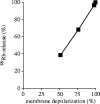Consequences of the electrogenic function of the phagocytic NADPH oxidase
- PMID: 16321799
- PMCID: PMC1569590
- DOI: 10.1098/rstb.2005.1768
Consequences of the electrogenic function of the phagocytic NADPH oxidase
Abstract
NADPH oxidase of phagocytic cells transfers a single electron from intracellular NADPH to extracellular O2, producing superoxide (O.-2), the precursor to several other reactive oxygen species. The finding that a genetic defect of the enzyme causes chronic granulomatous disease (CGD), characterized by recurrent severe bacterial infections, linked O.-2 generation to destruction of potentially pathogenic micro-organisms. In this review, we focus on the consequences of the electrogenic functioning of NADPH oxidase. We show that enzyme activity depends on the possibilities for compensating charge movements. In resting neutrophils K+ conductance dominates, but upon activation the plasma membrane rapidly depolarizes beyond the opening threshold of voltage-gated H+ channels and H+ efflux becomes the major charge compensating factor. K+ release is likely to contribute to the killing of certain bacteria but complete elimination only occurs if O.-2 production can proceed at full capacity. Finally, the reversed membrane potential of activated neutrophils inhibits Ca2+ entry, thereby preventing overloading the cells with Ca2+. Absence of this limiting mechanism in CGD cells may contribute to the pathogenesis of the disease.
Figures









Similar articles
-
Chronic granulomatous disease: more than the lack of superoxide?J Leukoc Biol. 2001 Feb;69(2):191-6. J Leukoc Biol. 2001. PMID: 11272268 Review.
-
Intracellular generation of superoxide by the phagocyte NADPH oxidase: how, where, and what for?Free Radic Biol Med. 2010 Dec 15;49(12):1834-45. doi: 10.1016/j.freeradbiomed.2010.09.016. Epub 2010 Sep 24. Free Radic Biol Med. 2010. PMID: 20870019 Review.
-
PEGylated D-amino acid oxidase restores bactericidal activity of neutrophils in chronic granulomatous disease via hypochlorite.Exp Biol Med (Maywood). 2012 Jun;237(6):703-8. doi: 10.1258/ebm.2012.011360. Epub 2012 Jun 19. Exp Biol Med (Maywood). 2012. PMID: 22715431
-
Hydrogen peroxide production in chronic granulomatous disease. A cytochemical study of reduced pyridine nucleotide oxidases.J Clin Invest. 1977 Jun;59(6):1088-98. doi: 10.1172/JCI108732. J Clin Invest. 1977. PMID: 193872 Free PMC article.
-
How superoxide production by neutrophil leukocytes kills microbes.Novartis Found Symp. 2006;279:92-8; discussion 98-100, 216-9. Novartis Found Symp. 2006. PMID: 17278388
Cited by
-
Hv1 proton channels are required for high-level NADPH oxidase-dependent superoxide production during the phagocyte respiratory burst.Proc Natl Acad Sci U S A. 2009 May 5;106(18):7642-7. doi: 10.1073/pnas.0902761106. Epub 2009 Apr 16. Proc Natl Acad Sci U S A. 2009. PMID: 19372380 Free PMC article.
-
Diverse novel functions of neutrophils in immunity, inflammation, and beyond.J Exp Med. 2013 Jul 1;210(7):1283-99. doi: 10.1084/jem.20122220. J Exp Med. 2013. PMID: 23825232 Free PMC article. Review.
-
Interactions between Neutrophils and Pseudomonas aeruginosa in Cystic Fibrosis.Pathogens. 2017 Mar 9;6(1):10. doi: 10.3390/pathogens6010010. Pathogens. 2017. PMID: 28282951 Free PMC article. Review.
-
Dysregulated Ca2+ homeostasis in Fanconi anemia cells.Sci Rep. 2015 Jan 28;5:8088. doi: 10.1038/srep08088. Sci Rep. 2015. PMID: 25627108 Free PMC article.
-
Intracellular shunting of O2(-) contributes to charge compensation and preservation of neutrophil respiratory burst in the absence of voltage-gated proton channel activity.Exp Cell Res. 2013 Jul 15;319(12):1875-1888. doi: 10.1016/j.yexcr.2013.03.031. Epub 2013 Apr 8. Exp Cell Res. 2013. PMID: 23578765 Free PMC article.
References
-
- Ahluwalia J, Tinker A, Clapp L.H, Duchen M.R, Abramov A.Y, Pope S, Nobles M, Segal A.W. The large-conductance Ca2+-activated K+ channel is essential for innate immunity. Nature. 2004;427:853–858. 10.1038/nature02356 - DOI - PMC - PubMed
-
- Bánfi B, Schrenzel J, Nüsse O, Lew D.P, Ligeti E, Krause K.H, Demaurex N. A novel H+ conductance in eosinophils: unique characteristics and absence in chronic granulomatous disease. J. Exp. Med. 1999;190:183–194. 10.1084/jem.190.2.183 - DOI - PMC - PubMed
-
- Davies E.V, Hallett M.B. High micromolar Ca2+ beneath the plasma membrane in stimulated neutrophils. Biochem. Biophys. Res. Commun. 1998;248:679–683. 10.1006/bbrc.1998.9031 - DOI - PubMed
-
- DeCoursey T.E. Voltage-gated proton channels and other proton transfer pathways. Physiol. Rev. 2003;83:475–579. - PubMed
Publication types
MeSH terms
Substances
LinkOut - more resources
Full Text Sources
Miscellaneous

